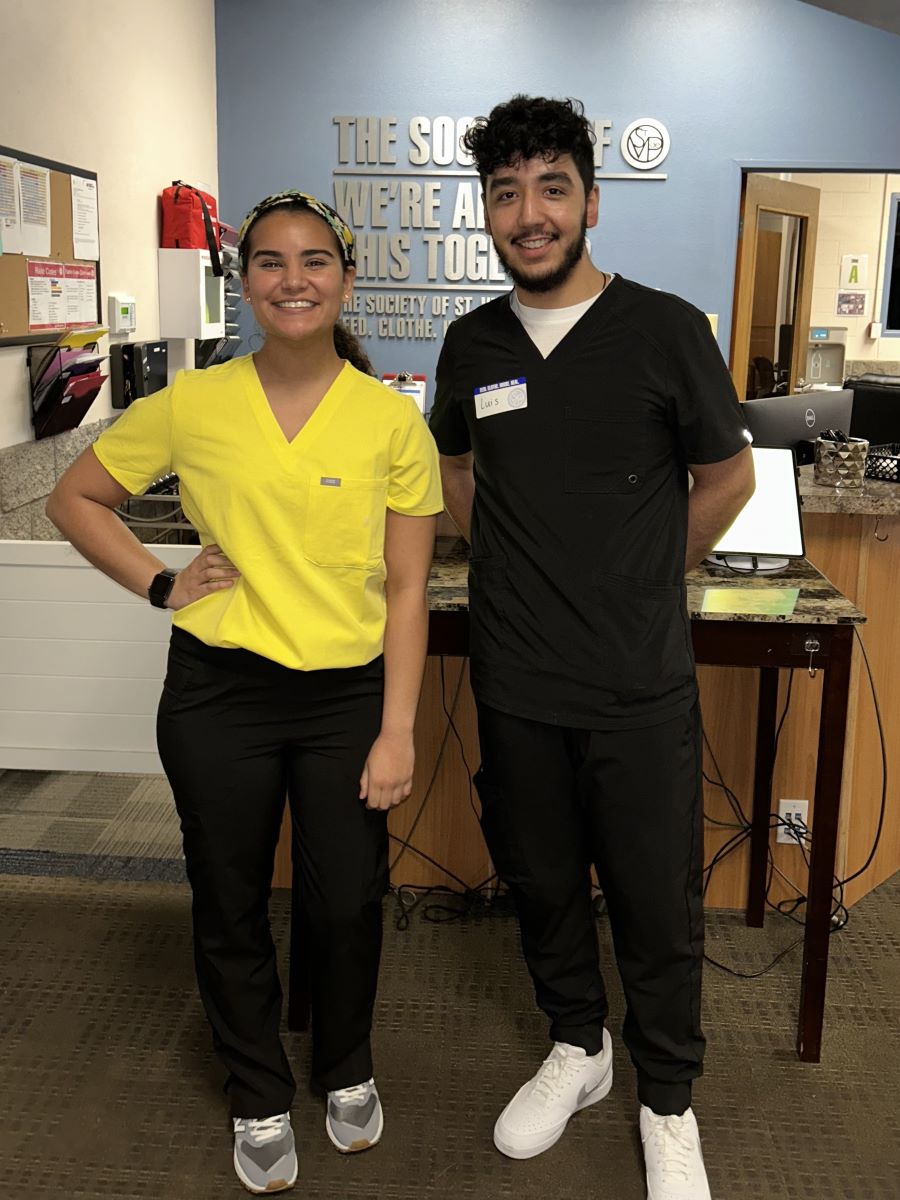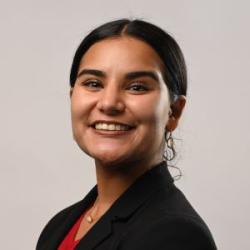
From left: Volunteers Jasmine Lopez and Luis Dominguez Monge after a volunteer shift at St. Vincent de Paul's Virginia G. Piper Medical Clinic
Silence filled the space between the child and me. As a volunteer at a sports-physical event, I was administering a vision exam at St. Vincent de Paul (SVdP), a free clinic in Phoenix, Arizona for uninsured patients. Seconds before the silence, I had pointed to a line of letters on a vision chart and asked the child which letters they could see. After there was no response, I turned around and gently asked, “¿Hablas español? [“Do you speak Spanish?”],” in recognition of the large Spanish-speaking communities we serve.
Like night and day, the child transformed from shy and guarded to engaged, now using the language they felt comfortable with. Happily, we began the exam again in Spanish. I wrote down the results on their sports-physical sheet, then directed the child toward the next station. Every station— including dental exams and physician consultations—was essential for ensuring the children’s health.
Moments later, I watched another child go through their vision exam with a fellow volunteer. After the child confidently read aloud each letter on a line, they stumbled on one specific letter. Without hesitation, the volunteer asked if they knew how to say the letter in Spanish instead of in English. The child replied proudly, “Zeta,” for the letter Z.
These interactions with the children left me with heavy “What if?” questions. What if they had been seen at a different clinic that did not have access to the cultural awareness or language skills to recognize the patients’ needs? What if a clinic was so busy that their needs were overlooked? Would their results be different, and would this have a cascading effect on their overall health care experiences? Moreover, if free clinics like SVdP did not exist, would the children even have health care access?
At St. Vincent de Paul, I recognize that phrases such as “health equity,” “health disparities,” and “unfavorable social determinants of health” are not just that… phrases. They are the embodiment of failures in the health care system to see, listen to, and care for patients of all backgrounds, identities, cultures, and socioeconomic statuses. The significance of these phrases arose from the long history1 of why they even exist in the first place — inequity.
At St. Vincent de Paul’s free clinic, the reality of inequity is not separated from the communities we serve. The high rates of uninsured children in Arizona2(pp7-10) — one of six states that were home to almost 50% of uninsured children across the nation between 2008 and 20182(p7) — amplify the importance of free clinics like St. Vincent de Paul and their sports-physical events, including the one where I volunteered. Furthermore, stressors’ effects on health3, such as from trauma, financial strain, hypervigilance, and discrimination3, are hard to miss at the clinic: in a patient’s high blood pressure reading, from racing to their appointment in traffic, and in the hidden trauma behind a child’s innocent answers, on a questionnaire, about their mental health.
Moreover, the goal of equity does not go unrecognized by the health professionals, staff, medical students, and volunteers at St. Vincent de Paul. Seeing a predominantly Latino medical staff represent and serve the communities at SVdP reminds me that volunteering at the free clinic is more than community service and gaining exposure to medicine; it is an affirmation of the value of diversity in health care4 and improving patients’ trust.5,6 Volunteering at SVdP especially affirms my dream of becoming a physician. Beyond the clinic’s walls, I am filled with an immense sense of purpose, noticing the resemblance between people in my own family and the communities we serve. I thought of my grandma when a patient said to me, “Muchas gracias — eres muy amable [“Thank you so much — you’re very kind”]” after I handed them a note with their physician’s guidance in Spanish.
I am continuously learning from the examples set by the health professionals and medical students at St. Vincent de Paul. The impact of their work was described by a patient in The Lancet Rheumatology; “When I arrived at St. Vincent de Paul, even the doctors were crying with me, suffering with me. And now when I see them, I not only see them as doctors, I see them as my family….”7 Similarly, I aspire to follow in the footsteps of the health professionals at SVdP by:
- Writing down notes or printing handouts in patients’ preferred language for their reference, according to their individual levels of health literacy and needs.8,9
- Looking up the lowest price of medications online and the nearest pharmacies.
- Showing patients visuals as appropriate, in accordance with what the physician is discussing.10,11
- Maintaining eye contact and awareness of nonverbal communication when interacting with diverse communities.12
- Recognizing complementary and alternative medicine practices and their intersection with patients’ cultures,13 such as the use of herbal remedies in the Latino community.14
St. Vincent de Paul is an example of a free clinic that plays a direct role in addressing the trauma, resource limitations, lack of health insurance, financial challenges, health literacy, and cultural differences described firsthand by patients15 in the AAMC videos on Achieving Health Equity and Social Justice for Newly Arrived Immigrants in Arizona and Beyond. Through building trustworthiness with historically marginalized communities, organizations like St. Vincent de Paul are in a unique position to carry out the focus areas established at a systemic level by the Center for Health Justice. In my roles as a volunteer at St. Vincent de Paul and as an AAMC biomedical research workforce specialist, I have come to understand how commitment, actions, and a health justice lens at every level of the system, from individuals to leadership, are needed to work toward achieving health equity.
